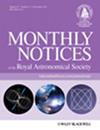On the Dust properties of the UV galaxies in the redshift range z ∼ 0.6 − 1.2
IF 4.7
3区 物理与天体物理
Q1 ASTRONOMY & ASTROPHYSICS
引用次数: 0
Abstract
Far-infrared observations from the Herschel Space Observatory are used to estimate the infrared (IR) properties of ultraviolet-selected galaxies. We stack the PACS (100, 160 μm) and SPIRE (250, 350 and 500μm) maps of the Chandra deep field south (CDFS) on a source list of galaxies selected in the rest-frame ultraviolet (UV) in a redshift range of 0.6 − 1.2. This source list is created using observations from the XMM-OM telescope survey in the CDFS using the UVW1 (2910 Å) filter. The stacked data are binned according to the UV luminosity function of these sources, and the average photometry of the UV-selected galaxies is estimated. By fitting modified black bodies and IR model templates to the stacked photometry, average dust temperatures and total IR luminosity are determined. The luminosity-weighted average temperatures are consistent with a weak trend of increasing temperature with redshift found by previous studies. Infrared excess, unobscured, and obscured star formation rate (SFR) values are obtained from the UV and IR luminosities. We see a trend in which dust attenuation increases as UV luminosity decreases. It remains constant as a function of IR luminosities at fixed redshift across the luminosity range of our sources. In comparison to local luminous infrared galaxies with similar SFRs, the higher redshift star-forming galaxies in the sample show a lesser degree of dust attenuation. Finally, the inferred dust attenuation is used to correct the unobscured SFR density in the redshift range 0.6-1.2. The dust-corrected SFR density is consistent with measurements from IR-selected samples at similar redshifts.关于红移范围 z ∼ 0.6 - 1.2 的紫外星系的尘埃特性
赫歇尔空间天文台(Herschel Space Observatory)的远红外观测数据被用来估算紫外选区星系的红外(IR)特性。我们将钱德拉深场南半球(CDFS)的PACS(100、160微米)和SPIRE(250、350和500微米)地图叠加到一个在红移范围0.6-1.2的静帧紫外(UV)星系源列表上。该源清单是利用 XMM-OM 望远镜在 CDFS 中使用 UVW1(2910 Å)滤光片进行的巡天观测结果创建的。根据这些源的紫外光度函数对叠加数据进行了分档,并估算了紫外选区星系的平均光度。通过将修正的黑体和红外模型模板拟合到叠加光度测量中,确定了尘埃的平均温度和红外总光度。光度加权平均温度与之前研究发现的温度随红移增加的微弱趋势一致。根据紫外和红外亮度,我们得到了红外过量、未遮挡和遮挡恒星形成率(SFR)值。我们发现一个趋势,即尘埃衰减随着紫外光度的降低而增加。在我们的光源的光度范围内,它与固定红移下的红外光度的函数关系保持不变。与具有类似 SFR 的本地红外亮度星系相比,样本中红移较高的恒星形成星系的尘埃衰减程度较小。最后,利用推断出的尘埃衰减来校正红移范围 0.6-1.2 的未遮挡 SFR 密度。尘埃校正后的 SFR 密度与红外选择样本在类似红移下的测量结果一致。
本文章由计算机程序翻译,如有差异,请以英文原文为准。
求助全文
约1分钟内获得全文
求助全文
来源期刊

Monthly Notices of the Royal Astronomical Society
ASTRONOMY & ASTROPHYSICS-
CiteScore
9.10
自引率
37.50%
发文量
3198
审稿时长
3 months
期刊介绍:
Monthly Notices of the Royal Astronomical Society is one of the world''s leading primary research journals in astronomy and astrophysics, as well as one of the longest established. It publishes the results of original research in positional and dynamical astronomy, astrophysics, radio astronomy, cosmology, space research and the design of astronomical instruments.
 求助内容:
求助内容: 应助结果提醒方式:
应助结果提醒方式:


